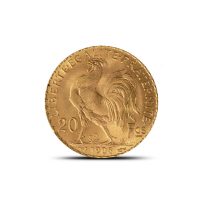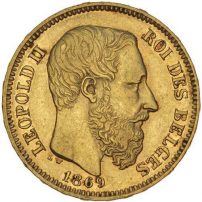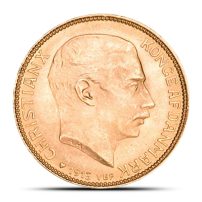







Modern gold bullion coins have been issued as investment-grade pieces since the 1967 release of the South African Gold Krugerrand. However, gold coins have been issued around the world for hundreds or thousands of years in many nations. The United States formerly issued gold coins in circulation for use in commercial transactions, including the famed Eagle collection with the Half Eagle and Double Eagle serving as popular examples.
European gold coins were also issued in varying denominations in countries throughout the continent. Many were used for hundreds of years, with some of those European Gold Coins used across national boundaries and representing currency that some call “the Euro before the Euro.” Below you’ll find a breakdown of the European Gold Coins now available from JM Bullion. These former circulation pieces make a great addition as an investment or collectible piece.
One of the most notable gold coins in European history is the British Gold Sovereign. The modern version of the Gold Sovereign was introduced in 1817 during the reign of King George III. The Recoinage of 1817 brought the Gold Sovereign back after a more than 210-year absence. The coins are based on the original concept of the English sovereign, gold coins that were introduced by the Tudor monarch King Henry VII with effigies of the monarch on the obverse and other symbols on the reverse.
The modern British Gold Sovereign is available as the Sovereign, Half-Sovereign, and Double-Sovereign. The coins were originally intended as circulation pieces, but were largely out of issue as circulation pieces by World War I. After World War II, the coins returned to production, but were now largely available as commemorative and, later, bullion investment coins.
From the introduction of the first Gold Sovereign to the latest issues of the investment-grade coin, the designs have largely remained the same, at least in terms of focus. The reigning monarch of Britain is always featured on the obverse of the coin. Over time, the British monarchs to feature on the coins have been depicted in alternating left- or right-profile relief with or without one of the many British crowns on their head. Monarchs to have appeared on the coins include:
The two most common obverse effigies are those of Queen Victoria and Queen Elizabeth II. These two influential female monarchs are the longest-reigning British monarchs in the history of the kingdom, with Queen Elizabeth II surpassing the length of her great-grandmother’s reign in 2015 to become the longest-reigning Queen. The effigies of Her Majesty, Queen Elizabeth II consist of five designs in total used from 1953 to the present.
On the reverse of the British Gold Sovereign, you will find one of two possible designs used throughout the program’s history. When the series was introduced in 1817, Benedetto Pistrucci created a vision of St. George slaying the dragon while riding on horseback. This image was used from 1817 to 1837 and has been in use again as of the 1880s. During a portion of Queen Victoria’s reign, the St. George design was replaced with a version of the Royal Arms on the reverse.
Another of the common coins you will find available among European gold coins are those from Austria. Gold coins issued by Austria are some of the most diverse in Europe due to the size and scope of the Austrian Empire, and later the Austro-Hungarian Empire. The third-largest empire in the world at the time, Austria issued gold coins for circulation use in a variety of different denominations.
If there was one common feature of Austrian gold coins of the 19th and early-20th centuries, it was the obverse image of Emperor Franz Joseph I. One of Europe’s longest-reigning monarchs in history, he first ruled as the Emperor of the Austrian Empire, and later served as the Emperor of the Austro-Hungarian Empire after its merger with the Kingdom of Hungary. During this period, he held the dual titles of Emperor of Austria and King of Hungary. By and large, Franz Joseph I was depicted in right-profile relief in a bust that captured only his head. He was rarely featured on Austrian coins with a crown on his head, though gold coins issued within Hungary in the empire did feature a full bust of his standing figure with an ornate crown upon his head.
The reverse side of Austrian gold coins varied greatly based on a number of factors that included the denomination and the area of release. Most Austrian gold coins were issued with the coat of arms of the Austro-Hungarian Empire on the reverse. This design borrowed heavily from the House of Habsburg seal, using a crowned double-headed eagle with the national shield on its chest. Other designs, notably the Austrian Schilling, merely featured a face value encircled by a wreath.
Examples of possible denominations in Austrian gold coins include, but are not necessarily limited to, the following:
The French Franc is one of the most deeply rooted European Gold Coins you’ll find available today as investment or collectible purchase options. The first use of the term “franc” to refer to a gold coin originated in France between 1360 and 1380. A silver coin was issued with the “franc” denomination from 1575 to 1641, and eventually became the nation’s official currency from 1795 to 1999.
Most of the French Francs available today come from the 19th century and early 20th century. Beginning in 1803, the French Empire under Napoleon issued gold francs in varying denominations such as 5 Francs, 10 Francs, 20 Francs, and 40 Francs. The most commonly issued coins in this currency were the 20 Francs and 40 Francs denominations. The coins typically featured the portrait of France’s ruling emperor or, during periods of the French Republic, the image of a French president.
Napoleon Bonaparte was the first to appear on these modern European Gold Coins. His nephew Napoleon III appeared on the coinage from 1848 to 1870 first as the president of the French Republic, and later as the emperor during the renewed French Empire in the late 19th century. The reverse of the coins either featured the coat of arms for France or the legend of its face value and year of issue inside of a wreath circle.
In 1865, France founded the Latin Monetary Union and established a common standard for gold content in the Francs used by other nations in Europe. By the late 19th century, many other nations were using the Franc as a name for national currencies. Most notable among them was the Swiss Confederation. Although this union dissolved with the outbreak of World War I in Europe, Switzerland continues the use of the Swiss Franc to this day.
The Swiss Franc was first issued by the Helvetic Republic from 1798 to 1847, and later by the Swiss Confederation. The Swiss Francs feature the design of Helvetia on the obverse. She is the female personification of Switzerland and is often depicted on European Gold Coins in left-profile relief with her hair down and a small braid of hair across the top of her head. In the background, you’ll notice the towering peaks of the Swiss Alps. The reverse of these Swiss Francs includes the national shield of Switzerland.
The first Dutch gold coin recognized internationally was the Dutch gulden in 1517, but the previous Kingdom of Holland issued gold coins as early as 1378. The Dutch Guilder was the official currency of the Netherlands from the 17th century until 2002 and the adoption of the Euro by the member nations of the Eurozone. Dutch Guilder Gold coins were issued primarily in 10 Guilder and 5 Guilder denominations.
The Dutch Guilder European Gold Coins featured the effigy of the ruling King or Queen of the Netherlands. The most common depictions remaining to this day are those which bear the portrait of Queen Wilhelmina. She was the only child of King William III and her left-profile portrait appeared in various generational designs from 1890 to 1948 when she abdicated the throne as Queen of the Netherlands. The reverse of the coins typically featured the coat of arms for the Kingdom of the Netherlands. The Dutch Guilder currency was widely used throughout the Kingdom of the Netherlands, and the denomination itself is now only in use in the countries of Curacao and St. Maarten as the Netherlands Antillean Guilder. Both countries are independent nations within the Kingdom of the Netherlands.
The gold coins of the German Mark were among the shortest-lived European Gold Coins. The German Mark Gold Coin was primarily issued by the German Empire from 1873 to 1914. Prior to the unification of the regions of Germany in 1871, the independent German States that would come to form the German Empire issued various types of coins. Most states used the Vereinsthaler, a silver coin. Southern Germany used a gold coin known as the Gulden and Bremen used a gold coin based upon the Thaler.
German goldmarks, as the coins were known, became the only official legal tender of the German Empire on January 1, 1876. The coins featured the effigy of the ruling emperor of the German Empire on the obverse. On the reverse of the coins, you’ll find the Imperial German Eagle used as the official coat of arms for the German Empire. The outbreak of World War I in 1914 brought an end to the coining of German Mark gold coins. While available from 1873 to 1914, the German Mark Gold Coins were struck in 1, 2, 3, 5, 10, and 20 Mark denominations. The German Mark remained the official currency of the German nation through the Nazi Era and post-World War II West Germany until the introduction of the Euro.
JM Bullion has a variety of European Gold Coins available, both those listed above and other coins from smaller collections such as Russian Gold Roubles (Rubles). Feel free to reach out to JM Bullion with your questions at 800-276-6508, chat with us live online, or simply send us an email.